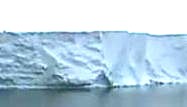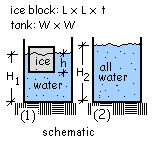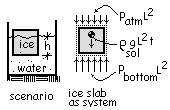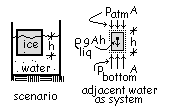| THERMO Spoken Here! ~ J. Pohl © | TOC NEXT ~ 92 |
Arctic Shelf-Ice
We use the Momentum Equation again.

The image shows an edge of the Ross Ice Shelf northeast of Canada. From its top to sea level the ice slab measures about twenty meters. Presently about 5 million square miles of similar shelf-ice float on the seas of Earth. In many places that ice is melting. As floating ice melts and descends into the sea does it cause the sea level to rise?
Calculate the height of rise of sea level.
♦ System selection is always the first step. Our first system-related image is ice floating in the sea. But since the ice becomes liquid water and the consequent depth of the sea is to be calculated, our analysis will require us to have some amount of ice and at least some sea as system. To include the entire water of all seas is unnecessary. At any instance there is an average elevation of Earth's contiguous seas relative to some mountain peak or geodetic benchmark.
We take our system to be a tank containing a piece of ice
 floating water at that average depth.
floating water at that average depth.
Floating in the tank is a slab of ice (measuring L by L with thickness, t). The tank which measures W by W, has an Earth-average sea depth of sea water , H1. Our system sketch includes a second state (2) in all water is liquid. That sketch shows the assumption that the sea level indeed rises: H2 is shown as greater than H1. For this "average section of all of the seas" and the ice it floats, the mass equation is:

| (1) 1 |
Initially there is solid and liquid:

| (2) 2 |
Finally there is only liquid:

| (3) 3 |
Thus the mass equation says:

| (4) 4 |
The densities, ρsol and ρliq are known constants and the dimensions, W, L and t are arbitrary. Thus the above equation appears to have three unknowns which are the initial (average) floating depth of the ice slab, h, and the initial and final depths of the sea, H1 and H2. However, we can group the two depth-unknowns together as: H2 - H1.
 So we have one equation and one two unknowns; insufficient information to answer our question.
So we have one equation and one two unknowns; insufficient information to answer our question.
For more information, the momentum equation is applied to a section of ice slab in its initial, floating state. The sketch (right) shows the isolated system bounded by its "dotted line." The momentum equation is applied.

| (5) 5 |
 This provides another equation but it brings another unknown, pbottom.
A final available condition is that of static equilibrium of the water adjacent to the ice. The system is shown (right). We write the momentum equation for a column of water of depth h.
This provides another equation but it brings another unknown, pbottom.
A final available condition is that of static equilibrium of the water adjacent to the ice. The system is shown (right). We write the momentum equation for a column of water of depth h.

| (6) 6 |
Again, pbottom appears, but it has already been counted as an unknown. Thus the equations (A), (B) and (C) can be combined to yield the expression:
ρliqW2(H2 - H1) = 0 | (7)(7) |
When the product of three quantities equals zero, one quantity must equal zero. Obviously ρliq is not zero. W is not zero. Hence, it must be that:
|
H2 - H1 = 0 | (8)(8) |
Thus when ice floating in the sea melts the average depth of the ocean does not change. However, when ice that is initially on land melts, the average sea level rises.
Arctic Shelf-Ice
 The image shows an edge of the Ross Ice Shelf northeast of Canada. From its top to sea level
the ice slab measures about twenty meters. Presently about 5 million square miles of similar
shelf-ice float on the seas of Earth. In many places that ice is melting. As floating ice melts into the sea, calculate the height of rise of sea level.
The image shows an edge of the Ross Ice Shelf northeast of Canada. From its top to sea level
the ice slab measures about twenty meters. Presently about 5 million square miles of similar
shelf-ice float on the seas of Earth. In many places that ice is melting. As floating ice melts into the sea, calculate the height of rise of sea level.
Premise presently unwritted!